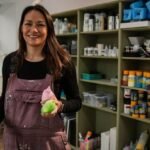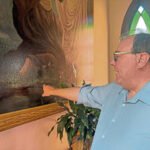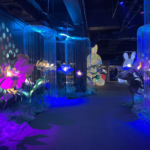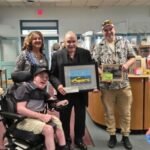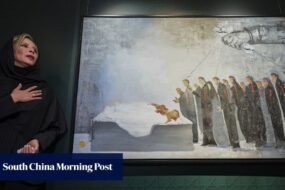
“I think it would be really difficult if we weren’t both artists because it consumes everything,” says Findlay. “You wake up at seven o’clock, you start working and you stop at eleven at night because you’re tired.”

Bissland agrees. “If we had partners that didn’t do this, they wouldn’t understand. We put all our time into this. We have a TV in our living room that never goes on. We’re always painting, and we make our own frames too.”
The couple literally paint back-to-back in their shared studio space, sometimes working so hard that lunch is eaten standing up in front of the easel. Mutual support, then, is the name of the game.
“Our interests are similar but I think it helps that our subjects are different,” says Findlay. “I love Dale’s work, and it inspires me watching him work. There’s an element of having an artist with you being really helpful, because for years I didn’t. It’s very hard being an artist on your own, to keep that momentum going that you need.”
A power couple, then? They laugh at the tag, though perhaps there’s an element of truth to it. “Although we are very independent as artists and will do separate things, we are a unit as well,” Findlay admits.
Art lovers can sample the strength of that unit and the power of its output from February 22 when The Lemond Gallery in Glasgow mounts a joint exhibition of the couple’s work.
Findlay’s main focus since leaving Glasgow School of Art (GSA) in 1996 has been portraiture, working mostly in oil but also in watercolour, pastels and pencil. At The Lemond Gallery she presents large works such as Branching Out, a triptych inspired by the work of Gustav Klimt, alongside interiors and portraits in pastel or oil. These are often enhanced with silver leaf.
Her work isn’t confined to canvas and paper either – vintage biscuit tins also feature, touching on an aspect of her practice which involves making miniatures. “I play with scale a lot, so I do huge things and tiny things,” she explains. “It’s sometimes harder doing a miniature because you can obliterate something if you get it wrong. As for the appeal, I’d need a psychiatrist! I think it’s because I love drawing. That’s the basis of everything I do, and to do things so tiny you really have to know how to draw, so it’s a challenge. I like the idea of things being quite precious and intimate as well. In the show are two small works called Nymph In Green and Nymph In Blue, and they’re painted on vintage tins – little old biscuit tins I found.”
Read more
Findlay’s path to GSA and to a life as a painter wasn’t exactly pre-destined – but it was pretty well mapped out given her family connection to the place. Her great-great-grandfather was the artist and educationalist Francis Newbery, director of GSA from 1885 until 1917, and the man who helped a certain Charles Rennie Mackintosh bag the commission to create the building which would come to be known the world over as The Mack.
Accordingly, Findlay grew up in a house filled with Newbery’s paintings as well as works by other artists, including Mackintosh.
“It gave me this unquestionable belief that you could be an artist and make a living from it,” she says. “So it was a wonderful foundation, which a lot of people don’t have. Also my parents encouraged me because it was in my background.”
Bissland, on the other hand, is entirely self-taught. “There was nothing like that in my family,” he says. “There was no art, no artists, no real creative people.”
Although advised to apply for art school, he followed his father into the building trade where he worked as an electrician and a joiner. But, he says, “I was really unhappy in the jobs I was doing.”
The desire to make art eventually became too strong when, fatefully, his mother gave him a painting set for his birthday. He started teaching himself to use it and began “relentlessly” studying art history. “As soon as I started putting the work on line it got an immediate response and it started selling very quickly,” he says. “Then I started approaching galleries.”

At The Lemond Gallery, Bissland will show landscapes such as Cows Under The Plough and Luminous Woods, works which evoke some of the same sense of mystery as Wyeth’s work while remaining true to the artist’s own desire to represent what he has termed ‘the ordinary encounter.’ What does he mean by that?
“Maybe just the way the light’s catching a tree,” he says simply. “Just a quiet little corner.”
Denise Findlay And Dale Bissland is at The Lemond Gallery, Glasgow, from February 22 to March 2 (open daily, 11am to 5pm)

